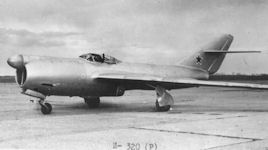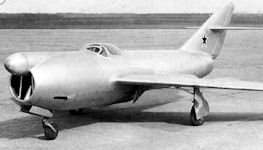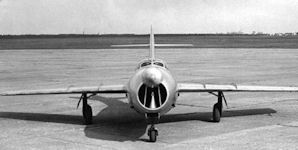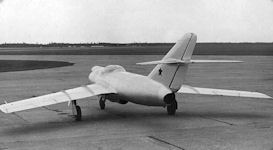MiG I-320 All-weather fighter-interceptor
In the task to develop a two-seater fighter-interceptor for air defense units, there were requirements for a considerable duration and range of flight, installations in addition to the conventional on-board weapons of the radar-type "Tory-A" to search for air targets. All these designers took into account when determining the scheme of the future aircraft, its general layout, in particular, the placement of two engines, the fuel system. Using the experience accumulated by the OKB team in creating the lighter predecessors of the interceptor, in particular the MiG-15 fighter, the designers placed the engines in a tandem (ledge). The nozzle of the front went out under the bottom of the fuselage, the second - in its tail part. Accordingly, large fuel tanks wer placed in a wide fuselage: one with a capacity of 1590 liters, for the front engine, the second - for 1545 liters, for the rear.
The first in the practice of the design bureau headed by AI Mikoyan and MI Gurevich , a large-sized fighter with a radar station was built in a short time. The pilots were located side by side in a broad cockpit ["lantern"] with armored glass 105 mm thick with electric heating. Tanks were soft (two at 3175 liters) in the fuselage. The engines were installed in the fuselage in series with a ledge. The front, in the fore part of it - with an exhaust nozzle under the fuselage behind the cabin, rear, behind the middle of the fuselage - with a nozzle under the vertical plumage. The air intake was a large common, with branching to the front and rear engines. Armament was three H-37 cannons along the sides and at the bottom of the forward fuselage from 50, later with 60 rounds each.
April 16, 1949 test pilot Ya.Vernikov began its factory tests. According to his feedback, the plane designated I-320 ("R") turned out to be quite good. Relatively simple in piloting, it possessed good stability and controllability, was close to the MiG-15 in terms of characteristics. However, during the state tests, the leading pilot Yu.A. Antipovdiscovered the propensity of the car to fall as a result of the divergence of the wing, so its maximum speed was limited to a limit of 960 km / h on the device. Remarks and wishes of pilots and test engineers were taken into account when constructing the second copy of the aircraft - I-320 ("P-2"). To improve the front sight, the ejection seats were raised. The cockpit was taller and received one pilot's and operator's backward sliding cover.
Although the design of the airframe remained unchanged, the fairing of the radar station was lowered. On the "R-2" installed two VK-1 engines with a thrust of 2,700 kg. In the anti-icing system of the aircraft, the wings of the wing and electric heaters in the tail unit assembled. The booster "R-2" with the same three guns H-37 increased from 150 to 180 cartridges.
After the first stage of the tests, the I-320 ("P-2") was returned to the plant for modifications. In the second half of 1950, a new wing with caisson tanks, included in its power circuit, was put on it. The wing consoles were reinforced. They installed three aerodynamic ridges instead of two. Interceptors were introduced at the top of the wing in the flap zone. The geometrical dimensions of the wings "P-1" and "P-2" were the same: the sweep along the line of foci - 35 °, the transverse V = -3 °, the angle of installation - + 1 °. area - 41.2 m2. The repair version of the "P-2" in some documents was called "P-3". It was distinguished by improved aerodynamics of the fuselage, cockpit lamp and exhaust turbojet nozzles. It also tested the new radar "Korshun" type.
| Modification | I-320 (I-2) |
| Wing span, m | 14,22 |
| Length, m | 15,77 |
| Wing area, m2 | 41,2 |
| Weight, kg- | |
| Empty plane | 7827- |
| Normal take-off | 10725 |
| -Maximum take-off | 12095 |
| Type of engine | 2 x TRD VK-1 |
| Traction, kgf | 2 x 2700 |
| Maximum speed, km / h | |
| on the ground | 1040 |
| at altitude | 994 |
| Cruising speed, km / h | 904 |
| Flight range, km | 1940 |
| Max. rate of climb, m / s | 2175 |
| Practical ceiling, m | 15500 |
| Crew, people | 2 |
| Armament | 3 x 37 mm H-37 cannons (60 rounds each). |
|
NEWSLETTER
|
| Join the GlobalSecurity.org mailing list |
|
|
|





